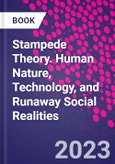Stampede Theory: Human Nature, Technology, and Runaway Social Realities explores the biological, evolutionary and technological systems that drive troubling patterns of behavior among groups while also proposing actions to combat harm. The book discusses different ways that living beings coordinate and how the emergence of communication technologies has changed behaviors. As the problem of echo chambers and misinformation grows, it is crucial to understand underlying causes and provide solutions-this book does just that by pulling from multiple fields to produce a coherent story about how social realities are created and how they can create resilient communities or reinforce damaging beliefs.
This interdisciplinary approach rests on three primary pillars: 1) How information systems affect the distribution of ideas, information, influence and belief; 2. Technology-mediated communication between individuals and groups, from stories pressed into clay tablets to "likes� on social media; 3) The sociology of behavioral bias in groups ranging from teams to nations. Because of its interdisciplinary foundations, the book includes chapters that address behavioral economics, cults, artificial intelligence, and the individual psychology of belief.� This will be a valuable resource for a range of readers, from political and social scientists to decision-makers in government and business, scientists in the fields of machine learning and AI, and more.
Please Note: This is an On Demand product, delivery may take up to 11 working days after payment has been received.
Table of Contents
I Theory
1. From the Serengeti to the Ecclesia
2. Deep Bias
3. Humans and Information
4. Human Belief Spaces
5. Influence + Dominance = Attention
6. Hierarchies, Networks, and Technology
II Practice
7. Interview with a Biased Machine
8. The Spacecraft of Babel
9. Influence Networks and the Power of Money
10. Cults, Hierarchies, and the Doomed Voyage of the Pequod
11. Escaping Cults, Deprogramming, and Diversity
12. Population-Computer Interfaces
13. Belief Geography and Cartography
14. Belief Stampedes
15. Future Cartographers
16. Epilogue
17. Definitions








